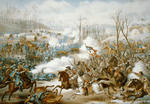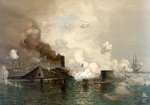Njaco
The Pop-Tart Whisperer
27 February 1861
President Davis in Montgomery named three Confederate commissioners to Washington, DC to attempt negotiations with the Federals. He chose Martin J. Crawford, John Forsyth and A.B. Roman. In Washington, DC the Peace Convention sent the results of its deliberations to Congress. Six constitutional amendments were proposed. First amendment - that involintary servitude be prohibited north of 360 30'; that in land south of the line slavery could exist while such area was a territory and Congress could not hinder it; that upon admittance as a state it could come in with or without slavery as its state constitution provided. Second Amendment - no further territory would be acquired except through treaty and by consent of four fifths of the Senate. Third Amendment - that Congress could not regulate, abolish or control slavery in the states or territories. Fourth Amendment - fugitive slave provisions of the Constitution should be enforced and Congress should not interfere. Fifth Amendment - that the foreign slave trade be prohibited. Sixth Amendment - there should be compensation for loss of fugitives from labor in certain cases. There was much dissatisfaction with the results and they never stood a chance in Congress. The Peace Convention had not even been too peaceful, with much bickering and dissatisfaction among its members.
From Charleston Governor Pickens wrote President Davis;
In Washington Lincoln was listening not only to politicians about appointments, but to others such as Senator Douglas and border-state men, pleading for conciliation or compromise. In the House proposal after proposal was voted down. A plan for a constitutional convention lost; the Crittenden proposal finally lost; an amendment not to interfere with slavery lost but was reconsidered the next day.
27 February 1862
The Confederate Congress gave President Davis the power to suspend the privilege of habeas corpus, which was sparingly used. President Davis ordered martial law for the threatened cities of Norfolk and Portsmouth, VA in the wake of the launching of the USS 'Monitor'.
27 February 1863
President Davis called for a day of fasting and prayer on March 27. Confederate Maj. Gen. Sterling Price was ordered to the Trans-Mississippi Department. There was a skirmish near Bloomington on the Hatchie River in TENN., a Federal expedition from Fort Pillow, TENN; and a 2 day scout from Centreville to Falmouth, VA.
27 February 1864
Near Americus, GA Federal prisoners of war began arriving at an unfinished prison camp, officially Camp Sumter, but known to history as Andersonville. Insufficient food, shelter, clothing and accommodations made the prison notorious.
The Demonstration by Federals on Dalton, GA ended with a skirmish at the Stone Church near Catoosa Platform or Station. Skirmishing took place in the Sequatchie Valley, TENN; at Madisonville and Sharon, MISS; near Poplar Bluff, MO; and at Pinos Altos, Arizona Territory. Federals destroyed large Confederate salt works on Goose Creek near St. Marks, FLA.
27 February 1865
The Shenandoah valley was coming alive again. Sheridan's force of some 10,000 Calvary under immediate command of Wesley Merritt left Winchester, VA., heading south. Sheridan had orders from Grant to destroy the Virginia Central Railroad and James River Canal, take Lynchburg and then either join Sherman or return to Winchester. Early, in front of him, had only e weakened brigades and a few pieces of artillery, his other troops being employed elsewhere. In the Carolina campaign, minor skirmishing flared near Mount Elon and Cloud's House, SC. The only other actions were near Sturgeon, MO. and Spring Place, GA.
.

President Davis in Montgomery named three Confederate commissioners to Washington, DC to attempt negotiations with the Federals. He chose Martin J. Crawford, John Forsyth and A.B. Roman. In Washington, DC the Peace Convention sent the results of its deliberations to Congress. Six constitutional amendments were proposed. First amendment - that involintary servitude be prohibited north of 360 30'; that in land south of the line slavery could exist while such area was a territory and Congress could not hinder it; that upon admittance as a state it could come in with or without slavery as its state constitution provided. Second Amendment - no further territory would be acquired except through treaty and by consent of four fifths of the Senate. Third Amendment - that Congress could not regulate, abolish or control slavery in the states or territories. Fourth Amendment - fugitive slave provisions of the Constitution should be enforced and Congress should not interfere. Fifth Amendment - that the foreign slave trade be prohibited. Sixth Amendment - there should be compensation for loss of fugitives from labor in certain cases. There was much dissatisfaction with the results and they never stood a chance in Congress. The Peace Convention had not even been too peaceful, with much bickering and dissatisfaction among its members.
From Charleston Governor Pickens wrote President Davis;
We feel that our honor and safety require that Fort Sumter should be in our possession at the very earliest moment.
In Washington Lincoln was listening not only to politicians about appointments, but to others such as Senator Douglas and border-state men, pleading for conciliation or compromise. In the House proposal after proposal was voted down. A plan for a constitutional convention lost; the Crittenden proposal finally lost; an amendment not to interfere with slavery lost but was reconsidered the next day.
27 February 1862
The Confederate Congress gave President Davis the power to suspend the privilege of habeas corpus, which was sparingly used. President Davis ordered martial law for the threatened cities of Norfolk and Portsmouth, VA in the wake of the launching of the USS 'Monitor'.
27 February 1863
President Davis called for a day of fasting and prayer on March 27. Confederate Maj. Gen. Sterling Price was ordered to the Trans-Mississippi Department. There was a skirmish near Bloomington on the Hatchie River in TENN., a Federal expedition from Fort Pillow, TENN; and a 2 day scout from Centreville to Falmouth, VA.
27 February 1864
Near Americus, GA Federal prisoners of war began arriving at an unfinished prison camp, officially Camp Sumter, but known to history as Andersonville. Insufficient food, shelter, clothing and accommodations made the prison notorious.
The Demonstration by Federals on Dalton, GA ended with a skirmish at the Stone Church near Catoosa Platform or Station. Skirmishing took place in the Sequatchie Valley, TENN; at Madisonville and Sharon, MISS; near Poplar Bluff, MO; and at Pinos Altos, Arizona Territory. Federals destroyed large Confederate salt works on Goose Creek near St. Marks, FLA.
27 February 1865
The Shenandoah valley was coming alive again. Sheridan's force of some 10,000 Calvary under immediate command of Wesley Merritt left Winchester, VA., heading south. Sheridan had orders from Grant to destroy the Virginia Central Railroad and James River Canal, take Lynchburg and then either join Sherman or return to Winchester. Early, in front of him, had only e weakened brigades and a few pieces of artillery, his other troops being employed elsewhere. In the Carolina campaign, minor skirmishing flared near Mount Elon and Cloud's House, SC. The only other actions were near Sturgeon, MO. and Spring Place, GA.
.
Last edited:


